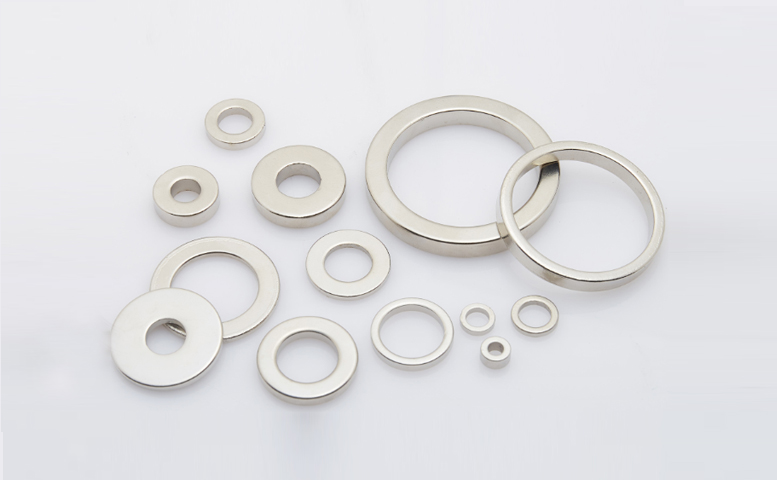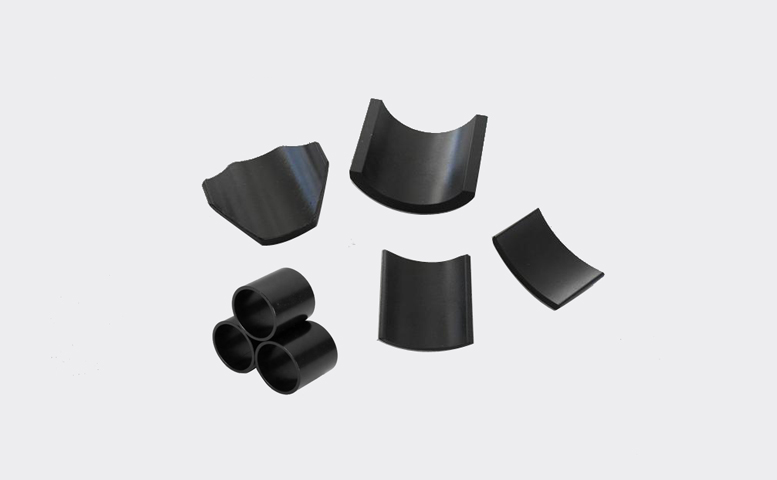Neodymium iron boron is mainly divided into sintered neodymium magnets and bonded neodymium magnets according to different processes. There are some introductions online about the comparison of these two types of magnets, but it is still not comprehensive. Therefore, Chinese magnet supplier courage magnet will provide a comprehensive introduction, including production process, density, magnetic force, magnetization method, surface treatment, application, price, advantages and disadvantages, etc.
1、 Appearance of bonded and sintered neodymium magnets
The surface of bonded neodymium iron boron is mostly coated with black or gray epoxy, with a black color and relatively thin wall thickness. Sintered neodymium iron boron is often coated with zinc plating or nickel copper nickel, with a silver white appearance,
The following picture shows neodymium ring magnets of various sizes

Bonded neodymium arc and ring magnets for motor;

2、Sintered ndFeb vs bonded NdFeb processing technology
Bonded NdFeB magnet is made of ndFeb magnetic powder and adhesive, bond is actually injection molding, there are four main processing methods, namely rolling, injection molding, extrusion molding and compression molding, injection molding and compression molding are commonly used. Pressure molding is to mix magnetic powder and adhesive in proportion, add a certain amount of coupling agent after granulation, pressure molding in the mold, 120°~150° curing, and finally get the finished product. Using solid epoxy resin or phenolic resin, the addition amount of 1%~5%, can be large size and simple shape of permanent magn
et bonding.
Sintered NdFeb is vacuum through high temperature heating molding, generally through sintering can only produce blank, and then through mechanical processing (such as wire cutting, slicing, grinding, etc.) to become a variety of shapes of magnets. Sintered NdFeb is a hard and brittle material that is difficult to process. In the process of processing, the loss is large, the cost is high, the dimensional accuracy is poor, the corrosion resistance is poor, and the surface needs electroplating treatment. But the advantage is higher magnetic properties!
3、 Which is the higher density of sintered or bonded neodymium magnets?
The density of bonded neodymium iron boron is about 6 grams per cubic centimeter. The density of sintered neodymium iron boron is about 7.5 grams per cubic centimeter.
4、 Sintered and bonded NdFeb magnetic comparison
Bonded ndfeb materials contain less neodymium and are less magnetic than sintered neodymium iron boron.
5、 The price of sintered and bonded neodymium magnets
The price of bonded neodymium iron boron will be relatively cheaper, but production requires molds and magnetizing fixtures. Sintered neodymium iron boron can be directly processed without molds, and specific quotations can be provided to us with dimensions.
6、Comparison of magnetization modes
Bonded neodymium magnets are mainly multipole magnetization, such as radial multipole, axial multipole, ring magnets can also be internally magnetized, externally magnetized.
Most sintered neodymium magnets are commonly magnetized, with only NS 2 poles.
7、Their advantages and disadvantages;
Advantages of bonded neodymium magnets:
The preparation process is relatively simple and can be mass produced.
Magnets of various shapes and sizes can be prepared.
The preparation cost is relatively low.
Disadvantages of bonded neodymium magnets:
The presence of a binder may cause the magnetic properties of the magnet to decrease slightly.
The mechanical strength of bonded magnets is low and fragile.
The magnetic properties of bonded magnets will decrease at high temperature.
Advantages of sintered NdFeb magnet:
Magnets have high mechanical strength and magnetic properties.
The size precision of magnet is high and the shape complexity is high.
Magnets have good magnetic properties and stability at high temperature.
Disadvantages of sintered neodymium magnets:
It is relatively brittle, and the higher the magnetic performance level, the more brittle it is, making it easy to break.
Easy to oxidize and corrode
Curie temperature is relatively low and will lose its magnetism within a certain temperature range.
Environmental issues, sintered neodymium iron boron magnets contain the rare earth element neodymium, and the mining and extraction of rare earth elements have a certain impact on the environment.
Our company can provide samples of the above two kinds of magnets, processing and customization, if you need, please feel free to contact us.
Recommended articles that may interest you;
Molded Bonded NdFeB vs Injection NdFeB Magnets
Bonded NdFeB Physical Characteristics and Properties DataSheet
 China Neodymium And Ferrite Magnets Manufacturer & Supplier
China Neodymium And Ferrite Magnets Manufacturer & Supplier 


